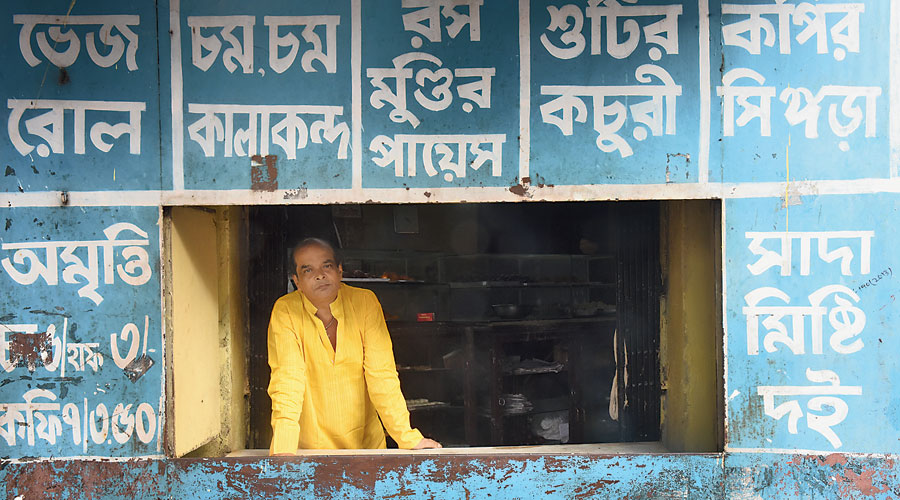A city usually comes with two kinds of environmental heritage: natural and built. In Calcutta both are under tremendous threat. About our city being the cultural capital of India, the less said the better. Calcutta, many feel now, has only one real heritage item to showcase: its food.
The city lives, breathes and certainly eats its food. The past is never disowned when it comes to food. It is cherished, rediscovered, maintained and even fought over. Look how passionately Bengal staked its claim to rosogolla. True, tradition is often subjected to “fusion”; and the purist may object to a lyangcha tart. But done well, it leaves a much better aftertaste than bling on Tangail.
Not that Calcutta food — especially its world of mishtis — is sweet and uncomplicated. The lyangcha is being challenged by the tart. Also, there is a caste system. When it comes to mishtis, the North looks down on the South. Ask a connoisseur about the heritage mishti shops of Calcutta and he is likely to rattle off a procession of names that spell vintage, class and refinement: Girish and Nakur, Bhabatarini, Makhanlal Das, Putiram, Haridas Modak and Bhim Chandra Nag. None of these addresses are located in the other side of Dharmatala. Yes, there may be a Balaram or a Mithai in the South, but North Calcutta is a star-studded show.
So a place like Mrityunjay Ghosh and Sons, or just “Mrityunjay” as it is known in and around Lansdowne Road, where it is located, almost opposite Lansdowne Market, does not enjoy that privileged a place in this hierarchy. Those who know Mrityunjay, however, think of it as joy in the morning, to quote P.G. Wodehouse.
The air around the almost 90-year-old shop, which has the names of its mishtis and savoury items written in clear bold, Bengali letters in white against blue on its spectacular front, is redolent with the smells of its kochuri and singara. The singara has a slightly sweet edge. The matarshuti kochuri and the radhaballabhi are served with aloor torkari or chholar dal. They are fried fresh. It is hard for the morning walker to ignore that smell and keep going.
The lyangchas are soft, succulent and plump. But the most special item served here is roshomundir payesh — tiny rosogollas half-drowned in sweet heavy thickened milk.
The man behind the counter, which is a rectangle cut out on the front, is also the proprietor of Mrityunjay, Somnath Ghosh. He is as unassuming as the shop he runs. The sales from the shop has gone down quite a lot during the lockdown. But that does not prevent Ghosh from there every day at the shop from early morning.
He admits that his shop is well-loved in the locality, and adds that one of the most famous Bengali celebrities was among his loyal customers, but he looks slightly surprised about his interview.
The shop was started by his grandfather, Mrityunjay, a resident of Howrah who came over to the South. It was handed down to his father and then he joined the business. “That was in 1978, after I graduated in commerce from South City College,” Ghosh said.
He takes me through the contents of the old-fashioned showcase that houses the mishtis. An unperturbed, jovial, friendly man, he is most willing to answer my questions, but has very little to say about himself.
“The main thing is the chhana ,” he said.
Almost nothing has changed in the shop since its beginning. Above hangs the beamed ceiling, from which are suspended two large whirring ceiling fans. On one wall hang two large framed photographs, of Ghosh’s father and grandfather. Two attendants help Ghosh man the shop. The only piece of decoration in the whole establishment is its inscribed front.
“And we use fresh ingredients,” adds Ghosh, still answering the question on what makes the mishtis special. But listening to his voice inside the barely-lit shop, a feeling of stillness seems to be settling down inside you along with the gorgeous roshomundi you have just had, muting the din of a busy Calcutta street, noisy despite the lockdown.
Everything around Mrityunjay has changed. The buildings, the shops. Just opposite Mrityunjay is a shop called Selfie.
Mrityunjay items have not changed, too. The different types of sandesh with a coloured layer, chhanar jilipi, rosogolla, pantua, seeta bhog, kalakand — all remain the same as the past, from the time of his grandfather. “I have only added the gur-kalakand,” says Ghosh. The use of gur in making mishtis throughout the year is one big change from the past. He has stopped short of experimenting with the newer ingredients, like chocolate.
At this point my reverie about the past is broken rudely. Ghosh informs me that he is just waiting to “modernise” the place. He is prevented from doing so at the moment because of some practical reasons, but will definitely as soon as he can. What will he change? “Everything,” he says. He points at the showcase, the wall cupboards with the wooden doors, everything.
I suddenly feel another little piece of old Calcutta disappearing. But in a city like ours, one person’s heritage is another’s inconvenience. And in the absence of any real thinking about heritage by the authorities, modernisation only means a complete overhaul of the past.
But Ghosh did not say anything about the modernisation of the mishtis. I hold on to that as I walk away.










